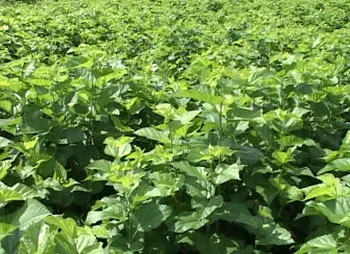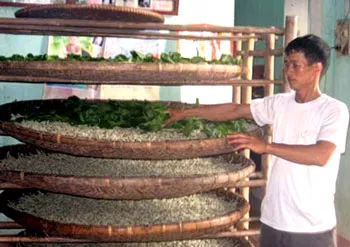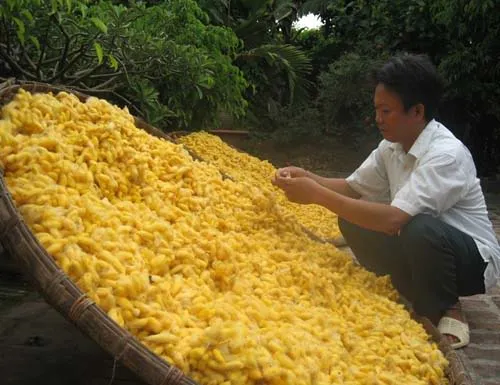Sericulture, the practice of silk farming, is not merely an economic activity but also a distinctive part of Vietnam’s cultural heritage, passed down through generations. In Bac Giang province, this traditional craft has deeply rooted itself, particularly in the two renowned villages of Mai Thuong (Hiep Hoa) and Hop Thinh. Join “Du lịch khắp thế gian” on a journey to explore the traditional silk farming in Bac Giang, where lustrous silk threads are woven from the diligence, meticulousness, and cultural essence of the local people.
Mai Thuong Village: Preserving the Soul of 800-Year-Old Silk Craft
Nestled peacefully beside the poetic Cau River, Mai Thuong village, located in Mai Dinh commune, Hiep Hoa district, Bac Giang province, proudly stands as one of the cradles of sericulture in Vietnam with the longest history. With over 800 years of formation and development, Mai Thuong silk craft was officially recognized as a traditional craft village by the Bac Giang Provincial People’s Committee in 2010, marking a significant milestone in preserving and promoting the unique cultural values of the locality. Visiting Mai Thuong, tourists not only admire the lush green mulberry fields stretching along the river but also witness firsthand the meticulous and elaborate silkworm rearing and silk reeling process, imbued with the essence of the village’s artisans.
Since ancient times, the people of Mai Thuong have been closely associated with mulberry trees and silkworms. The folk saying “raising pigs for a year is not as profitable as raising silkworms for one batch” partly reflects the economic value that sericulture brings to the people here. At one point, this craft contributed up to 70% of the income of many families in the village. Every house in Mai Thuong seemed to have looms, silkworm trays, the sound of shuttles, and the whirring of silk reeling machines echoing throughout the village, creating a distinctive cultural space of the Northern countryside.

To create quality silk products, the people of Mai Thuong have accumulated and passed down valuable experiences in mulberry cultivation and silkworm rearing. From selecting mulberry varieties, tending mulberry fields, to silkworm rearing and silk reeling techniques, all require meticulousness, caution, and a deep understanding of the growth characteristics of mulberry trees and silkworms.
The Elaborate and Meticulous Silkworm Rearing Process of Mai Thuong People
Silkworm rearing in Mai Thuong is not just a livelihood but also an art, requiring care and meticulousness like nurturing a child. Therefore, this occupation is often suitable for families with regular labor at home. Among the stages, silkworm rearing is considered the most important, determining the yield and quality of silk cocoons.
Silkworm farmers in Mai Thuong always strictly adhere to the silkworm rearing process according to each stage of silkworm development. From when silkworms are small until they mature, going through 4 molting periods, farmers must ensure appropriate feeding, temperature, and humidity. Traditional experience shows that for silkworms to spin silk evenly and produce quality cocoons, they need to be fed mulberry leaves on time, usually every 2 hours after silkworms go through molting periods.

Especially when silkworms turn golden yellow, preparing to spin silk, the process of moving silkworms onto cocooning trays requires agility and dexterity to avoid making silkworms “tear up,” affecting cocoon quality. The spirit of solidarity and mutual support is also a beautiful cultural aspect of the people of Mai Thuong in silkworm rearing. When it comes to the cocooning tray setting season, just a word, neighbors are ready to help, creating a warm and meaningful working atmosphere.
The final step to complete the silkworm rearing process is “sun-drying” and “dew-drying” cocoons. Silkworm farmers must dry cocoons in mild sunlight or dry them at a moderate temperature to ensure cocoons are dry, fragrant, and not moldy, while also making silk threads become golden and easier to reel.
The close relationship between mulberry cultivation, silkworm rearing, and silk reeling is well understood by the people of Mai Thuong. They always pay attention to mulberry cultivation, because mulberry leaves are the only food for silkworms, directly determining the quality of silk. Mulberry leaves must be clean, not contaminated with pesticides or chemicals, and especially not grown near plants with odors such as tobacco or chili.
Hop Thinh: A Silk Village Resiliently Overcoming Ups and Downs
Along with Mai Thuong, Hop Thinh is another commune in Hiep Hoa district also famous for its long-standing sericulture. The “standing-meal” profession in Hop Thinh has gone through many ups and downs, once seemingly fading away, but the people here have persistently clung to and preserved the traditional craft of their ancestors.
Currently, Hop Thinh commune has more than 1,400 households engaged in mulberry cultivation and silkworm rearing with a mulberry area of about 40 hectares. Ninh Tao village is considered the largest mulberry growing area in the commune, almost every household raises silkworms, some raising dozens of trays. Villages along the Cau River such as Da Hoi, Dong Dao, and Huong Ninh also maintain sericulture thanks to the advantage of fertile alluvial soil, suitable for mulberry trees to grow. Sericulture not only provides a stable source of income but also contributes to creating a unique cultural identity for the Hop Thinh countryside.

Strolling along the village roads of Hop Thinh, visitors will easily encounter images of lush green mulberry fields stretching out, trays of bright yellow cocoons being dried in front of houses, and silk looms weaving… All creating a peaceful and prosperous rural picture, rich in Vietnamese cultural identity.
Value and Potential of Sericulture in Modern Society
In today’s modern life, when many new materials and technologies have emerged, silk products still maintain their position as a high-end commodity, favored both domestically and internationally. The natural beauty, softness, breathability, and luxury of silk are factors that make this product always have a firm foothold in the market.
Sericulture not only brings economic value but also contributes to preserving and promoting the precious traditional cultural values of the nation. Craft villages like Mai Thuong and Hop Thinh are vivid evidence of the crystallization of diligent and creative labor and the essence of Vietnamese culture.
In the context of deep international integration, sericulture in Bac Giang is facing great opportunities to expand cooperation, invest in production, create unique silk products, and enhance the added value for Vietnam’s textile and garment industry. At the same time, developing craft villages in a sustainable direction will contribute to improving people’s incomes, preserving and promoting traditional cultural identity, and creating attractive tourism products, attracting domestic and international tourists to explore and experience.
Conclusion
The journey to explore sericulture in Bac Giang, especially in the craft villages of Mai Thuong and Hop Thinh, is not only an opportunity to discover a unique traditional craft but also a chance to deeply feel the culture, history, and people here. Sericulture is not only the livelihood of generations of Bac Giang people but also a part of cultural heritage that needs to be cherished, preserved, and promoted. Are you ready for a trip to Bac Giang to discover and experience the interesting things about sericulture?